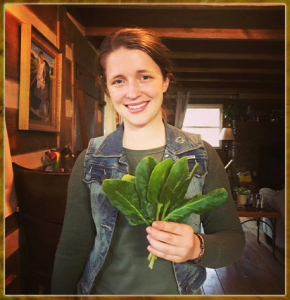Ayurveda: Utilizing the Sister Science of Yoga

Ayurveda is an ancient Indian healing science and often considered the sister science to yoga, and it focuses on healthy digestion, routine, and self-care. One of the tenets of this ancient healing system is the idea of doshas. According to Ayurveda, doshas are the energy principals that make up life. These doshas are called vata, pitta, and kapha. Each dosha corresponds to a different element of nature, and while each person contains elements of each dosha within us, all of us have a primary dosha. Once we identify our primary dosha, we can begin to discover which foods and activities can bring our lives into better balance.
Kimber Jones, an Ayurveda practitioner, will lead an Ayurveda workshop at YAM’s Laurel Park studio in June. I asked Kimber some questions about Ayurveda to get a brief overview of this healing science and what students can expect from her workshop.
Mandy H:
Can you give me a quick overview of ayurveda for those not familiar with it?
Kimber J:
Ayurveda is the ancient health and wellness system that originated alongside yoga in ancient India. It is holistic, totally individualized, and preventative medicine. It re-attunes us to nature’s rhythms with lifestyle recommendations for your unique body type/personality as well as the seasons and time of life. It is the one stop shop for incredible health.
MH: Can you give me an overview of the three doshas for those not familiar with them?
KJ: The doshas are just energy types. They make up everything around us, as well as each of us! We all have our own unique ratio of vata, pitta, and kapha that is our individual blueprint to health.
VATA: The power of movement
Based in the elements of air and ether.
Folks with lots of vata LOOK LIKE- tall, thin/lanky, big joints, darker hair/skin, curly/kinky/frizzy hair
FEEL LIKE- spontaneous, creative, talkative, lots of energy, can’t sit still
OUT OF BALANCE- dry skin, constipated, insomnia, gas/bloating, anxiety/ungroundedness
PITTA: the power of transformation
Based in the elements of fire and water
LOOK LIKE- medium build, blonde, red, or light brown hair, maybe freckles, build muscle easily
FEEL LIKE- driven, goal-oriented, transformative, gets stuff done and make stuff happen, hard workers
OUT OF BALANCE- acne/rashes, indigestion/reflux, diarrhea, redness/irritation/inflammation, quick to anger
KAPHA: the power of nourishment
Based in the elements of water and earth
LOOK LIKE- bigger boned, big welcoming eyes, greasy but thick luxurious hair
FEEL LIKE- community builders, easy-going, nurturing, loyal, care-takers, steady, reliable
OUT OF BALANCE- lethargic, heavy, dull, unmotivated, mucus, sinus infections, water retention, depression
MH: How are the seasons connected to the doshas?
KJ: Ayurveda gives an outline for how to reattune to nature’s rhythms. That is both seasonally, daily, and through different times of life. No matter what our own unique ratio of the doshas may be, we ALL get an extra dose of a certain dosha with each season. The hot, fiery nature of summer means we all feel a little extra pitta in our systems. The dry, windy, cooler, changing season of fall gives us all a shot of vata. Winter’s heavy, cold, but still dry nature gives us vata and kapha. The wet, heaviness of spring means it’s some extra kapha for all of us.
Ayurveda gives us ways to balance each of these doshas depending on the season with specific lifestyle suggestions for diet, food, daily routine, exercise, sleep, etc.
MH:What can people expect from your ayurveda workshop?
KJ: My workshop will start with a good 101 level introduction to Ayurveda. We will go through the elements, the doshas, and then determine your own unique ratio of the doshas (called your constitution). The second part will be based on the summer season so we will dive deep into pitta balancing practices. Diet, sleep, exercise, self-care practices, yoga and meditation, herbs and medicine, and more!
The workshop will be engaging, full of great info, and geared towards the questions and interests of the particular group of students attending.
MH: How do you think people can integrate ayurveda into their daily lives?
KJ: The real purpose of Ayurveda is to give you an owner’s manual to your own body. You can finally understand what the blinking lights mean- whether that is seasonal allergies, migraines, or gas. You know how your body is trying to communicate with you and what you can do to right the course of your ship. Simple daily choices add up to your overall health. Ayurveda helps you make more informed choices. Even if it is something as simple as skipping the ice water at lunch or favoring cilantro over black pepper, it gives you the tools to be in control of your own experience in your body.
Kimber’s workshop will be on June 12th from 1-3 at YAM’s moon studio. The cost is $25. Be sure to register for the workshop here.
Blog by: Mandy Henderly

